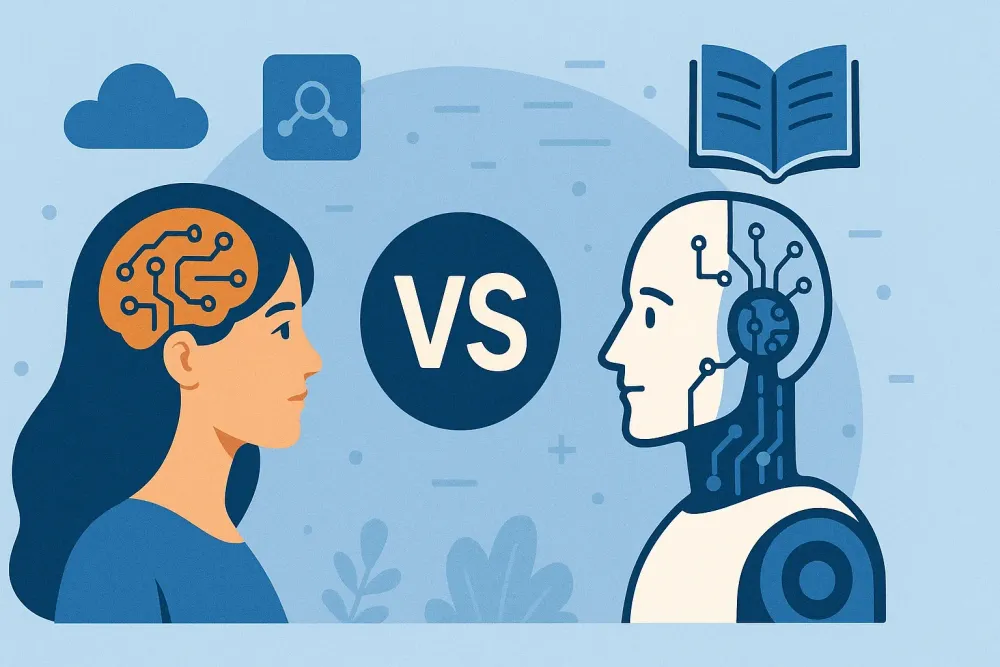Home
Services
Products
Projects
Who We Are
Blogs
Contact Us

Decoding Agentic AI vs. RAG: A Comprehensive Guide for Businesses
The rapid evolution of artificial intelligence continues to unveil innovative methodologies, two of which stand out: Retrieval-Augmented Generation (RAG) and Agentic AI. RAG excels at delivering contextually relevant responses by tapping into vast knowledge bases, while Agentic AI empowers autonomous intelligent agents capable of independent operation and decision-making. This comprehensive guide delves into the nuances of each, exploring their respective strengths, limitations, and potential applications for businesses.
Understanding Retrieval-Augmented Generation (RAG)
What is RAG?
RAG represents a sophisticated fusion of Large Language Models (LLMs) with external knowledge sources. This synergy enriches the accuracy and relevance of AI-generated responses. By seamlessly integrating information retrieval with natural language generation, RAG empowers AI systems to access and process real-time data from diverse databases and articles, bridging the gap between static training data and the dynamic nature of real-world information.
How Does RAG Work?
RAG operates through a multi-stage process:
- Information Retrieval: Upon receiving a user query, the system identifies relevant information within an external knowledge base. This is typically achieved using vector embeddings, converting documents into numerical representations for efficient searching.
- Language Model Processing: The LLM then processes this retrieved data in conjunction with its internal knowledge, generating a coherent and contextually relevant response. This process ensures that the output is grounded in reliable information.
Advantages of RAG
RAG offers several key advantages:
- Improved Accuracy and Relevance: Leveraging external knowledge enhances the precision of responses, directly addressing user queries.
- Enhanced Factual Grounding: Real-time data integration minimizes inaccuracies or "hallucinations" often associated with traditional LLMs.
- Ability to Handle Complex Queries: Access to a broader knowledge base equips RAG to effectively address intricate questions demanding detailed answers.
Limitations of RAG
Despite its strengths, RAG has certain limitations:
- Dependence on Knowledge Base Quality: RAG's effectiveness hinges on the quality and comprehensiveness of its data sources. Subpar data can compromise response accuracy.
- Lack of Autonomy and Proactive Behavior: Unlike Agentic AI, RAG lacks autonomous capabilities and relies solely on user input, limiting its proactive potential.
Exploring Agentic AI
What is Agentic AI?
Agentic AI defines systems capable of autonomous operation, goal-oriented behavior, and continuous learning and adaptation. These systems can operate independently, making decisions based on predefined objectives without constant human intervention, effectively navigating complex scenarios.
How Does Agentic AI Work?
Agentic AI functions through several key mechanisms:
- Self-Preservation: Prioritizing operational integrity allows these systems to avoid risks and maintain functionality in dynamic environments.
- Goal-Directed Behavior: These systems actively pursue defined objectives, unlike traditional AI, which may perform tasks without understanding overarching goals.
- Learning and Adaptation: Agentic AI continuously learns and adapts its strategies to optimize performance and decision-making.
- Social Intelligence: Many Agentic AI systems possess social intelligence, facilitating effective interaction with humans and other intelligent agents.
Advantages of Agentic AI
Agentic AI offers numerous advantages:
- Proactive Problem-Solving: Identifying potential issues before escalation allows for timely interventions, enhancing operational efficiency.
- Continuous Learning and Improvement: These systems evolve and refine their decision-making through continuous learning.
- Ability to Handle Dynamic Environments: Agentic AI excels in unpredictable settings, adapting its actions based on real-time data and environmental changes.
Limitations of Agentic AI
Agentic AI also presents certain challenges:
- Potential for Unintended Consequences: Autonomy can lead to unforeseen outcomes if the system misinterprets data or makes erroneous decisions.
- Ethical Considerations and Bias: Ensuring fairness and accountability in decision-making is crucial to mitigate ethical risks and biases.
Comparing RAG and Agentic AI
Both RAG and Agentic AI represent powerful tools, but their approaches and capabilities differ significantly.
Key Differences Between Agentic AI and RAG
- Autonomy: RAG is reactive, responding solely to user queries, while Agentic AI operates autonomously, making independent decisions.
- Knowledge Base: RAG relies on a fixed knowledge base, while Agentic AI continuously learns and updates its knowledge.
- Goal-Oriented Behavior: RAG is task-focused, while Agentic AI is inherently goal-oriented.
- Learning and Adaptation: RAG has limited learning capabilities, while Agentic AI excels in continuous learning.
- Interaction Depth: RAG facilitates deeper contextual conversations, while Agentic AI enables complex multi-step interactions.
- Personalization: RAG offers contextualized responses, while Agentic AI can personalize interactions based on user history.
- Integration Capabilities: RAG integrates with knowledge bases, while Agentic AI can connect with diverse systems and APIs.
- Scalability: RAG is highly scalable for information retrieval, while Agentic AI offers flexible scalability for various applications.
- Interactivity Level: RAG is reactive, while Agentic AI is highly interactive, engaging in multi-turn conversations and adapting dynamically.
Real-World Applications of RAG and Agentic AI
- RAG Applications: Customer Service Chatbots, Search Engines, Content Generation
- Agentic AI Applications: Autonomous Vehicles, Robotics, Virtual Assistants
Future Trends and Implications
The convergence of RAG and Agentic AI promises to revolutionize information interaction and automated decision-making. Integrating RAG's data retrieval capabilities with Agentic AI's autonomy can lead to highly intelligent and proactive agents.
Ethical Considerations and Regulations
Ethical considerations, including bias, transparency, and accountability, are paramount. Robust regulatory frameworks are necessary to ensure responsible development and deployment.
Potential Societal Impacts
While promising increased productivity and efficiency, the societal impacts of these technologies, including job displacement, require careful consideration and proactive mitigation strategies.
Conclusion
Understanding the distinct characteristics of RAG and Agentic AI is essential for businesses seeking to leverage these technologies. RAG excels in information retrieval, while Agentic AI empowers autonomous decision-making. Defx encourages businesses to explore and innovate in this exciting field. Contact Defx today to harness the power of RAG and Agentic AI for your business needs. Visit Defx for valuable resources and exclusive services.
See More
Contact Us
Let’s make your Idea into Reality
Let's Talk
© Copyright DEFX. All Rights Reserved
GoodFirms ★ 4.2
Clutch ★ 4.2
Google ★ 4.2
